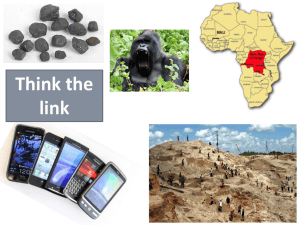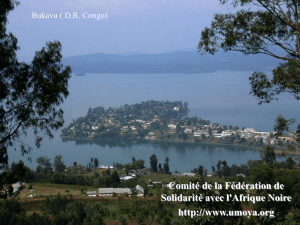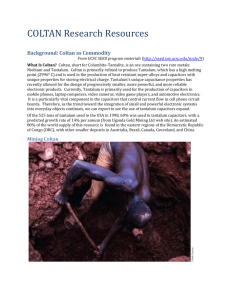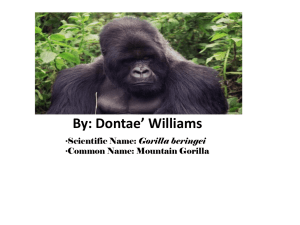Great Apes, Coltan and mobile phones
advertisement
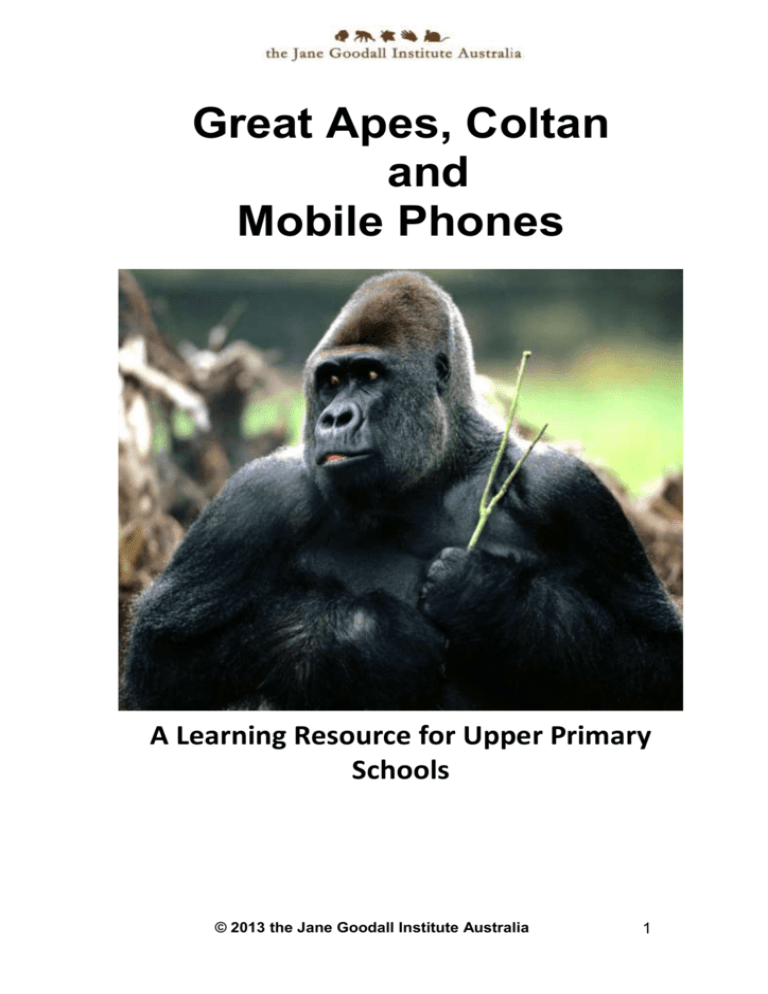
Great Apes, Coltan and Mobile Phones A Learning Resource for Upper Primary Schools © 2013 the Jane Goodall Institute Australia 1 1. Coltan You may not have heard of coltan, but you have it in your mobile phone, computer and other electronic devices. It is important in everyday communication and daily living everywhere. It is important, too, because the mining of coltan is threatening the lives of great apes (gorillas) and chimpanzees in central Africa. Unrefined coltan (Source: http://thedirty.biz/what-percentage-of-coltan-does-the-drc-actually-have) What Is Coltan? Coltan is the name given to a mineral ore which contains two minerals: columbite and tantalite. Coltan can be refined to produce tantalum, a powder which has a melting point of 2996 degrees celcius! Tantalum has become an important element in creating capacitors. Capacitors are devices which control the flow of electric currents inside devices like mobile phones, televisions and computers. Before tantalum capacitors were developed, capacitors made from other metals created a lot of heat inside electronic equipment. This caused problems for the operation of the equipment and increased the risk of the equipment melting or catching fire. Because tantalum capacitors are so heat resistant, they keep electronic equipment cooler, safer and more efficient. They are also much smaller than capacitors made from other metals. This makes them especially useful for small electronic devices like mobile phones. Tantalum capacitors are now used in almost all mobile phones, laptops, DVD players, LCD screens and many other electronics. © 2013 the Jane Goodall Institute Australia 2 Tantalum is also used to improve audio quality in mobile phones and televisions. Tantalum is, therefore, very important to electronics manufacturers like Apple, Samsung, Nokia, Sony, Panasonic, LG and Hewlett Packard. Only a small amount of tantalum - about 40 milligrams, is used in one mobile phone. However, there are more than 6 billion mobile phones in the world and this number will continue to increase. So the demand for tantalum, and coltan will also continue to increase. How valuable is coltan? The price of coltan and tantalum increased dramatically during the past 10 years – as sales of mobile phones, LCD television screens increased throughout the world. In 2012, the price of raw coltan was around $125 per pound (454 grams) and the price of tantalum powder (refined coltan) was around $330 per pound. Coltan is, then, a very valuable mineral. Tantalum powder ready to be supplied to electronics manufacturers. Each gram is worth about 75 cents. (Source: http://www.strategic-metal.com) Where is Coltan found? Coltan can be found on every continent. The largest amounts are in Africa, Australia, Canada, Brazil and Russia. It is estimated that one African country, the Democratic Republic of Congo, has the largest deposits: around 20% to 30% of the world total. Coltan is actively mined in Brazil, Canada, Australia, the Democratic Republic of Congo (DRC) and several other countries in Africa, including Ethiopia and Mozambique. © 2013 the Jane Goodall Institute Australia 3 Until a few years ago, Brazil and Australia were the largest producers of coltan. Today, increasing amounts are being mined in the DRC and elsewhere in Africa. In developed countries like Australia, Brazil and Canada, the government makes sure that coltan mines operate safely and that mining activities do not damage the local environment. Mining companies use modern mining equipment, provide a safe and healthy environment for the mine workers and pay them a good salary. They must also take care of the local environment so that plants and animals live safely and are protected from harm. Coltan mining in the Democratic Republic of Congo is very different. The Democratic Republic of Congo Named after the mighty Congo River, one of the world’s great rivers, the Democratic Republic of Congo (DRC) is a large country in central Africa. (Source: www.eco-friendly-africa-travel.com and http://geography.about.com ) Home to around 75 million people (called Congolese), and more than 240 different tribal groups, the DRC is a country of river plains and grasslands and mountains covered by rain forests and jungle. The DRC rain forests are the second largest in the world. (The largest are in Brazil in South America.) Although the DRC has some large cities, most Congolese people live in smaller towns and villages along and near the Congo River and its tributaries, and in villages scattered among the jungle and grasslands. Most people grow their own food in small gardens, catch fish and hunt animals in the jungle forests. © 2013 the Jane Goodall Institute Australia 4 The jungles and forests are also home to gorillas (also called ‘great apes), chimpanzees and other native animals. The DRC is a land of rivers, forests and jungle (Source: National Geographic) Gorillas There are several types of gorilla: the mountain gorilla and the eastern and western lowlands gorillas. They live only in Africa, and most live in the DRC. Where gorillas live (Source: http://www.un-grasp.org) © 2013 the Jane Goodall Institute Australia 5 Gorillas are our closest animal relatives. 98% of their DNA is the same as ours. They have no tails and they have four fingers and a thumb. Each gorilla has its own unique fingerprint, just like us. They can stand and walk upright. But they prefer to walk on all fours. Despite having large teeth, gorillas don’t eat meat. They only eat fruits, berries, nuts, leaves, grass, twigs and shoots and other wild plants. They also eat some types of small insects. They live in groups called ‘troops’ and spend much of the day wandering through the forest looking for food, and eating it. Gorillas have large stomachs and a large male gorilla will eat about 15 kg of food each day. They like a variety of food and are careful to conserve their food supplies. Every day, each troop spreads out over a wide area when they feed and always leave some food to eat at another time. They sleep in nests made of branches and leaves and make a fresh nest every night. Gorillas can live for up to 35 years in the wild – and for more than 50 years in zoos and conservation parks. A female gorilla can have up to 4 or 5 babies during her life. They nurse and carry each baby for up to 18 months – even though baby gorillas can live independently after about 6 months. Unfortunately only about 40% of baby gorillas live for more than two years! Many die of disease or because their mothers are killed by hunters who want their meat and skin. (Photo sources: http://photobucket.com) © 2013 the Jane Goodall Institute Australia 6 The DRC government tries hard to protect gorillas from hunters. It has created two national parks to protect them and their environment: the Virunga National Park near the eastern border with Uganda, and the KahuziBiega National Park near the border with Rwanda. Government rangers patrol the parks looking for hunters and poachers. But the parks are very large. There are not enough rangers. And the number of hunters and poachers increases every year. Rangers with a ‘congohound’ especially trained to sniff out poachers (Source: http://sitemaker.umich.edu) (Source: www.wildlifeextra.com) This situation has become worse since the demand for coltan has increased. Minerals and militias Like Australia, the DRC is rich in minerals and gemstones like diamonds, copper, gold, silver, zinc, manganese, tin, uranium, bauxite, iron ore, coal – and, of course, coltan. Unlike Australia, however, the DRC is not a safe, peaceful country. It has been in a state of civil war or in wars with its neighbours since 1998. It is estimated that more than 5 million Congolese have died because of the fighting. Millions more have lost their homes and land and become refugees inside their own country. They struggle to live. And the DRC central government still does not control all of the country. Local armies (called ‘militias’) from different tribal and political groups continue to fight for control of large areas of the country – and the DRC’s rich mineral resources. The militias control much of the mining activity and sell the minerals to get money so that they can continue the fighting. © 2013 the Jane Goodall Institute Australia 7 Congolese Militia (Source http://blogs.sacbee.com/photos/2008/11/congo-conflict-continues.html) Coltan mining Coltan can be found, in small deposits, in many parts of the DRC and especially near and in the Kahuzi-Biega National Park. Large machines cannot be used to mine the coltan - because the coltan deposits are so small. So the mining is carried out by individual and small groups of miners. Their methods are very similar to the methods used in the Australian goldfields during the 19th century: using picks, shovels, crowbars – and their hands. Primitive and dangerous methods are used to mine coltan (Source: Reuters) © 2013 the Jane Goodall Institute Australia 8 The small-scale mining of coltan (and other minerals) provides opportunities for Congolese people to earn an income. In many parts of the DRC it is the only opportunity to earn money. Up to 2 million Congolese men (and, in some cases, women and children) work as miners. Counting wives and children and other dependants, the total number of Congolese who rely on mining to live may be as high as 8 million – which is more than 10% of the total DRC population! Mining erodes the DRC landscape (Source: ABC Australia) Congolese miners earn between $1 and $5 per day – by working for the militias and others who control the mines, or by selling the coltan they have mined to the militias and other minerals traders. Militias also earn money by ‘taxing’ individual, independent miners. The Effects of Coltan mining: On people Although mining enables Congolese people to earn money, the work is very hard and very dangerous. There are no health and safety laws to protect miners. And there are usually no hospitals or medical clinics near the mine sites to care for miners who are injured or become ill. Living conditions for miners are very bad. Many have to live in huts and shacks made from bush materials. Water supplies are polluted by the mining activity. There is little, if any electric power. Sickness and disease are common, and deadly for miners and their families. There are few, if any schools for the children to attend. Food and other daily supplies are often scarce – and expensive, because many farmers, fishermen and timber workers leave their traditional work to © 2013 the Jane Goodall Institute Australia 9 go to the mines. And there is always the danger of the ongoing fighting between militias and central government soldiers. The Effects of Coltan mining: On the environment Coltan mining is having a serious effect on the natural environment of the DRC. Miners clear the forests and grasslands of vegetation to get to the minerals. Mature forest trees are cut down to build huts and houses, for use in the mining activity and for cooking fuel – as timber or charcoal. Mining activity pollutes rivers and streams, killing fish and other animals, and causing sickness and disease for the miners. The mining, and the removal of trees and other vegetation is eroding the landscape and making useless for farming and other productive activities The Effects of Coltan mining (and civil war): On the gorillas, chimpanzees and other animals Animals, and especially the Eastern Lowland gorillas who live in and near the Kahuzi-Biega National Park have been, and are being devastated by coltan and other mining.. Coltan mining is destroying the gorillas ’ habitat and food supply (Source: Pehhttp://maximusdrc.blogspot. com.auttp://maximusdrc) © 2013 the Jane Goodall Institute Australia 10 Worse, miners and others are killing more and more gorillas for their meat. Militias are also killing gorillas so that they can sell their meat and body parts. The civil warfare between militias and the central government is also having a direct effect on the lives of gorillas. More than 10,000 civilian refugees have fled the fighting and have set up camp in and near the Kahuzi-Biega National Park. They too are hunting gorillas as a source of food. It is estimated that, because of habitat loss, hunting and poaching, the number of Eastern Lowland gorillas in the Kahuzi-Biega National Park and nearby areas has declined from around 25,000 to about 5,000 during the past 15 years. Because of the ongoing fighting, the Kahuzi-Biega National Park has now been closed to visitors who go there, from all over the world, to view the gorillas. The visitor entrance fees are used to maintain the park, to employ rangers and others to care for and protect the gorillas and to conduct research about them. Without this money, the gorillas now have less protection and are in great danger of being wiped out completely. Will they survive without our help? (Source: : http://photobucket.com) © 2013 the Jane Goodall Institute Australia 11 What can be done to help save the gorillas? End the Fighting! Ending the civil war and other conflicts in the DRC is the first and best thing that will help protect and save the gorillas. The United Nations and other countries are already working hard to do this. Reduce the demand for coltan and other minerals! One way to reduce the demand for coltan (and tantalum) is to recycle mobile phones and other electronic devices. When mobile phones are recycled: other people can use them: they don’t need to buy a new phone, and the capacitors and other elements which use tantalum can be used again in the manufacture of new phones. and the demand for tantalum and other minerals used in mobile phones decreases. Recycling in our day to day lives helps to protect and sustain all living things: human beings, animals and all kinds of plants, big and small because it: Helps conserve important raw materials and protects natural habitats for the future by reducing demand and consumption Saves energy and reduces greenhouse emissions: Using recycled materials in manufacturing of new products requires much less energy and less energy is used in mining, transporting and processing raw materials Protects the environment from some of the harmful effects of mining and logging such as removing trees and vegetation and causing air and water pollution Reduces the need for rubbish dumps and landfill – which also cause pollution. Finally, there is one more very important way that recycling mobile phones can help protect the gorillas, chimpanzees and other animals in the DRC. Organisations like the Jane Goodall Institute and others collect used mobile phones and sell them to recycling companies and manufacturers. They use the money to support places like the Kahuzi-Biega National Park: to care for sick and injured animals, to pay and support the families of the park rangers and to continue research about gorillas and the way they live. So, you and your families CAN help to protect and preserve the wonderful animals of the DRC! © 2013 the Jane Goodall Institute Australia 12 Want to learn more? You can find more information about coltan mining, gorillas and the importance of recycling at the following websites and blogs: http://www.janegoodall.org.au http://en.wikipedia.org/wiki/Coltan http://www.youtube.com/watch?v=in0A8SFL3XM http://www.engineering.com/Library/ArticlesPage/tabid/85/ArticleID/83/Colu mbite-tantalite-COLTAN.aspx http://electronics.howstuffworks.com/capacitor.htm http://www.un.int/drcongo/war/coltan.htm http://www.globalissues.org/article/442/guns-money-and-cell-phones http://iphoneproj2011.wordpress.com/2011/04/19/coltan-mining-itsenvironmental-impacts/ http://worldwildlife.org/species/eastern-lowland-gorilla http://www.theage.com.au/environment/conservation/want-to-save-a-gorillaits-your-call-20090103-79hq.html http://gorillacd.org/ http://kahuzibiega.wordpress.com/gorillas/conservation/ http://kivumining.org/ © 2013 the Jane Goodall Institute Australia 13
